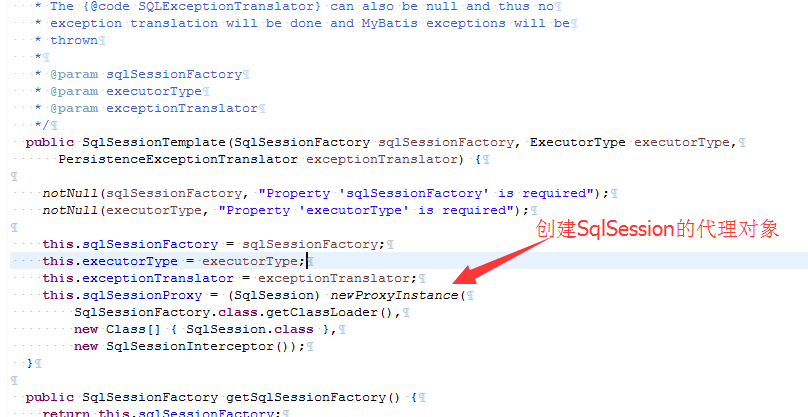MyBatis与Spring整合
1.单独使用MyBatis
单独使用MyBatis,不结合其他框架,主要步骤是:
1.创建SqlSessionFactory对象
创建方法是通过SqlSessionFactoryBuilder这个类从mybatis的XML配置文件,或者porperties,或者URL获取相关数据库的配置信息。
2.从sqlSessionFactory获取SqlSession。
3.使用SqlSession提供的API,对数据库进行增删改查,以及事务管理。
|
1
2
3
4
5
6
7
|
String resource = "org/mybatis/example/mybatis-config.xml";InputStream inputStream = Resources.getResourceAsStream(resource);SqlSessionFactory sqlSessionFactory = new SqlSessionFactoryBuilder().build(inputStream);SqlSession session = sqlSessionFactory.openSession();session.insert("BlogMapper.selectBlog", 101);session.commit();sesssion.close(); |
2.结合Spring框架使用MyBatis
MyBatis + Spring的使用方式,一般是在Spring的配置文件里,配置以下内容:
1.数据源(DataSource)
2.SqlSessionFactoryBean,实现FactoryBean接口,通过注入DataSource对象,以及MyBatis的相关配置信息,返回SQLSessionFactory对象。
|
1
2
3
4
5
6
|
<jee:jndi-lookup id="dataSource" jndi-name="jdbc/mysql"></jee:jndi-lookup><bean id="sqlSessionFactory" class="org.mybatis.spring.SqlSessionFactoryBean"> <property name="dataSource" ref="dataSource" /> <property name="configLocation" value="classpath:mybatis/mybatis-config.xml"></property> <property name="mapperLocations" value="classpath:mybatis/*/*.xml"></property></bean> |
加入以上的配置信息就可以Dao类里,直接引用sqlSessionFactory这个对象,对数据库进行操作(跟1的代码一样)。
如果Dao的代码写多了,这时候会发现,每次的数据库操作,步骤都是要先
①获取SqlSession对象->②调用数据库操作的方法->③提交事务->④关闭SqlSession
其中①③④这三个步骤会一直环绕在每个Dao的方法里。
这时候会这么想,能否提供这样一个功能,在调用方法之前自动获取SqlSession对象,在调用方法之后自动提交事务和关闭SqlSession对象。这样①③④这样重复的代码就可以剔除了,整个Dao类的代码也变得更加简洁。
3.SqlSessionTemplate的应用
上面提到的,在调用方法之前和调用方法之后,各执行一些操作。这种技术一下子就联想到就是AOP编程方式。
AOP是Spring的第二个核心功能,所以自然它也提供了这样的是一个实现类,就是SqlSessionTemplate
|
1
2
3
4
5
6
7
8
9
10
11
|
<jee:jndi-lookup id="dataSource" jndi-name="jdbc/mysql"></jee:jndi-lookup><bean id="sqlSessionFactory" class="org.mybatis.spring.SqlSessionFactoryBean"> <property name="dataSource" ref="dataSource" /> <property name="configLocation" value="classpath:mybatis/mybatis-config.xml"></property> <property name="mapperLocations" value="classpath:mybatis/*/*.xml"></property></bean> <bean id="sqlSessionTemplate" class="org.mybatis.spring.SqlSessionTemplate"> <constructor-arg ref="sqlSessionFactory" /></bean> |
引入SqlSessionTemplate这个类,在写Dao时,每个方法,在执行之前,自动获取SqlSession对象,执行之后,自动提交事务和关闭会话。
|
1
2
3
|
public Object save(String str, Object obj) throws Exception { return sqlSessionTemplate.insert(str, obj);} |
现在代码一下子变得更简洁了,只剩下数据操作的方法。
4.SqlSessionTemplate原理解析思路
为什么SqlSessionTemplate能够在每个方法,在执行之前,自动获取SqlSession对象,执行之后,自动提交事务和关闭会话。
要知道这个原理,其实相当于要了解Spring AOP原理。
要了解Spring AOP原理,就必须知道Java技术里,动态代理的原理。
Java的动态代理主要是涉及到JDK里java.lang.reflect包下的InvocationHandler接口和Proxy类里创建代理对象的方法。
SqlSessionTemplate的源码解析
SqlSessionTemplate的构造方法里,创建了一个SqlSession的代理对象。

在这个代理对象,每次SQLSession的方法被调用,都执行以下操作。

上面代码涉及到的知识点比较多,要完全理解,需要掌握下面列出的几点。
5.知识点归纳
1.MyBatis中的SqlSessionFactory和SqlSession
2.Spring中的SqlSessionFactoryBean和SqlSessionTemplate
3.Spring AOP原理
4.Java动态代理原理
5.Java反射原理
Spring与Mybatis四种整合方法
1、采用数据映射器(MapperFactoryBean)的方式,不用写mybatis映射文件,采用注解方式提供相应的sql语句和输入参数。
(1)Spring配置文件:
- <!-- 引入jdbc配置文件 -->
- <context:property-placeholder location="jdbc.properties"/>
- <!--创建jdbc数据源 -->
- <bean id="dataSource" class="org.apache.commons.dbcp.BasicDataSource" destroy-method="close">
- <property name="driverClassName" value="${driver}"/>
- <property name="url" value="${url}"/>
- <property name="username" value="${username}"/>
- <property name="password" value="${password}"/>
- <property name="initialSize" value="${initialSize}"/>
- <property name="maxActive" value="${maxActive}"/>
- <property name="maxIdle" value="${maxIdle}"/>
- <property name="minIdle" value="${minIdle}"/>
- </bean>
- <!-- 创建SqlSessionFactory,同时指定数据源-->
- <bean id="sqlSessionFactory" class="org.mybatis.spring.SqlSessionFactoryBean">
- <property name="dataSource" ref="dataSource" />
- </bean>
- <!--创建数据映射器,数据映射器必须为接口-->
- <bean id="userMapper" class="org.mybatis.spring.mapper.MapperFactoryBean">
- <property name="mapperInterface" value="com.xxt.ibatis.dbcp.dao.UserMapper" />
- <property name="sqlSessionFactory" ref="sqlSessionFactory" />
- </bean>
- <bean id="userDaoImpl2" class="com.xxt.ibatis.dbcp.dao.impl.UserDaoImpl2">
- <property name="userMapper" ref="userMapper"/>
- </bean>
- <beans:bean id="sqlSessionFactory" class="org.mybatis.spring.SqlSessionFactoryBean">
- <beans:property name="dataSource" ref="simpleDataSource" />
- <beans:property name="configLocation"
- value="classpath:conf/core/mybatis-config.xml" />
- </beans:bean>
- <beans:bean id="sqlSessionFactory_contact" class="org.mybatis.spring.SqlSessionFactoryBean">
- <beans:property name="dataSource" ref="simpleDataSource_contact" />
- <beans:property name="configLocation"
- value="classpath:conf/core/mybatis-config-contact.xml" />
- </beans:bean>
- <beans:bean id="transactionManager"
- class="org.springframework.jdbc.datasource.DataSourceTransactionManager">
- <beans:property name="dataSource" ref="simpleDataSource" />
- </beans:bean>
- <beans:bean id="transactionManager_contact"
- class="org.springframework.jdbc.datasource.DataSourceTransactionManager">
- <beans:property name="dataSource" ref="simpleDataSource_contact" />
- </beans:bean>
- <!-- <tx:annotation-driven transaction-manager="transactionManager" />
- <tx:annotation-driven transaction-manager="transactionManager_contact" />
- -->
- <bean id="userDao" class="org.mybatis.spring.mapper.MapperFactoryBean">
- <property name="mapperInterface" value="com.mybatis.UserDao"></property>
- <property name="sqlSessionFactory" ref="sqlSessionFactory"></property>
- </bean>
- <bean id="userService" class="com.mybatis.UserServiceImpl">
- <property name="userDao" ref="userDao"></property>
- </bean>
- <!-- 加载配置文件 -->
- <beans:bean name="mapperScannerConfigurer"
- class="org.mybatis.spring.mapper.MapperScannerConfigurer">
- <beans:property name="basePackage" value="com.elong.hotel.crm.data.mapper" />
- <beans:property name="sqlSessionFactoryBeanName" value="sqlSessionFactory"></beans:property>
- </beans:bean>
- <beans:bean name="mapperScannerConfigurer_contact"
- class="org.mybatis.spring.mapper.MapperScannerConfigurer">
- <beans:property name="basePackage"
- value="com.elong.hotel.crm.data.contact.mapper" />
- <beans:property name="sqlSessionFactoryBeanName" value="sqlSessionFactory_contact"></beans:property>
- </beans:bean>
- <tx:advice id="txAdvice" transaction-manager="transactionManager">
- <tx:attributes>
- <!-- name表示以什么开始的方法名,比如 add*表示add开头的方法 propagation表示事务传播属性,不写默认有 -->
- <tx:method name="save*" propagation="REQUIRED" />
- <tx:method name="insert*" propagation="REQUIRED" />
- <tx:method name="add*" propagation="REQUIRED" />
- <tx:method name="del*" />
- <tx:method name="update*" />
- <tx:method name="find*" read-only="true" />
- <tx:method name="get*" read-only="true" />
- <tx:method name="search*" read-only="true" />
- </tx:attributes>
- </tx:advice>
- <tx:advice id="txAdvice_contact" transaction-manager="transactionManager_contact">
- <tx:attributes>
- <!-- name表示以什么开始的方法名,比如 add*表示add开头的方法 propagation表示事务传播属性,不写默认有 -->
- <tx:method name="save*" propagation="REQUIRED" />
- <tx:method name="insert*" propagation="REQUIRED" />
- <tx:method name="add*" propagation="REQUIRED" />
- <tx:method name="del*" />
- <tx:method name="update*" />
- <tx:method name="find*" read-only="true" />
- <tx:method name="get*" read-only="true" />
- <tx:method name="search*" read-only="true" />
- </tx:attributes>
- </tx:advice>
- <!-- 配置事务切面 -->
- <aop:config>
- <aop:pointcut expression="execution(* com.elong.hotel.crm.service..*.*(..))"
- id="pointcut" />
- <aop:advisor advice-ref="txAdvice" pointcut-ref="pointcut" />
- <aop:advisor advice-ref="txAdvice_contact" pointcut-ref="pointcut" />
- </aop:config>



